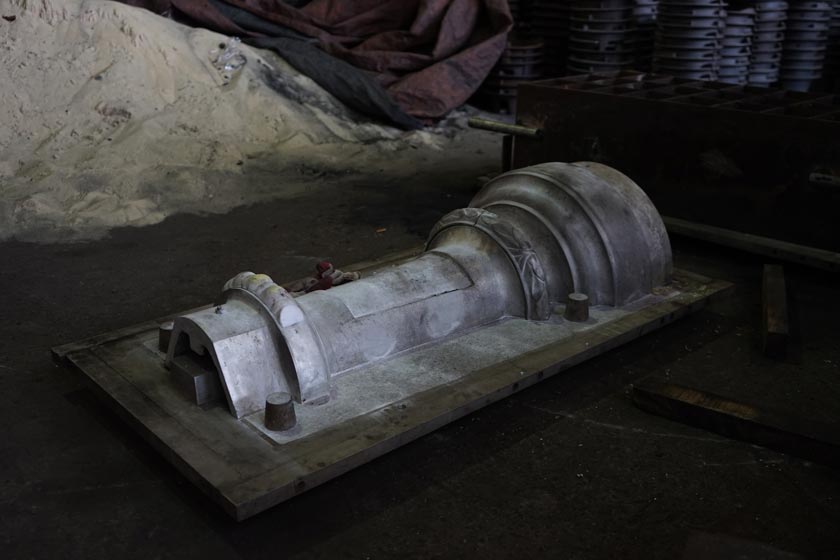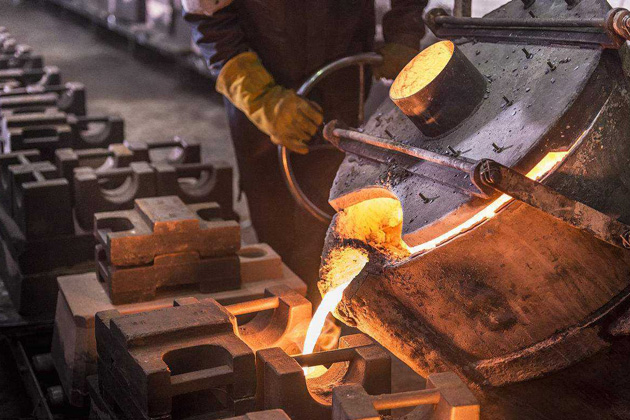Aluminum Foundry Wisconsin is a essential partner in casting solutions
Just How Aluminum Foundry Adds To Innovations in Aerospace Engineering
Aluminum foundries are important to developments in aerospace engineering. They create lightweight, high-strength components that are crucial for modern-day aircraft. Through innovative spreading techniques, these factories develop complicated geometries that improve architectural integrity. Additionally, the advancement of remarkable Aluminum alloys sustains the sector's concentrate on gas efficiency and sustainability. Nonetheless, difficulties continue to be in the manufacturing procedure. Understanding these elements discloses the extensive influence of Aluminum on aeronautics's future.
The Significance of Lightweight Products in Aerospace Layout
As the aerospace market proceeds to develop, the importance of lightweight products becomes significantly obvious. The demand for effectiveness and sustainability drives engineers to focus on the usage of materials that reduce general weight without endangering architectural honesty. Light-weight products, particularly Aluminum, play an essential role in improving fuel efficiency, boosting payload capacity, and enhancing the total efficiency of aircraft.
The combination of these materials permits for cutting-edge layouts, allowing manufacturers to produce even more aerodynamic shapes that can stand up to extreme conditions. The reduction in weight not only lowers functional prices however also adds to a decreased ecological footprint, straightening with international initiatives toward sustainability in aviation.
Advanced Casting Techniques in Aluminum Foundries
Advanced casting methods in Aluminum foundries play an important function in aerospace engineering by enabling the manufacturing of precise and lightweight parts. Innovations in mold and mildew design and precision casting procedures are vital in achieving optimal efficiency and structural honesty. Furthermore, the development of lightweight alloys boosts the overall efficiency and performance of aerospace applications.
Cutting-edge Mold Layout
Cutting-edge mold and mildew style plays a vital role in the efficiency and effectiveness of Aluminum factories, especially within the aerospace industry. By leveraging advanced products and methods, contemporary molds can be engineered to hold up against heats and stress, ensuring peak efficiency during the casting procedure. These layouts frequently integrate complex geometries that enable the production of lightweight yet structurally audio elements, essential for aerospace applications. Furthermore, making use of computer-aided layout (CAD) software assists in accurate modeling, enabling foundries to replicate and refine mold styles prior to physical production starts. This not just boosts the quality of cast parts but likewise decreases waste and lead times, bring about significant expense financial savings. Generally, innovative mold and mildew design is a keystone of progression in Aluminum Foundry technology for aerospace design.
Accuracy Casting Processes
The performance of ingenious mold designs flawlessly integrates with precision casting procedures, which are vital for producing high-quality Aluminum elements in aerospace engineering. These procedures, consisting of sand casting, die spreading, and financial investment spreading, ensure the development of intricate geometries with limited resistances. Advanced strategies like vacuum spreading and pressure die casting improve the integrity and surface finish of the end products. Precision casting decreases product waste while optimizing the mechanical residential or commercial properties of Aluminum, critical for aerospace applications. In addition, utilizing real-time tracking and progressed simulation tools throughout the spreading procedure enables prompt modifications, leading to improved quality assurance. Jointly, these precision spreading procedures position Aluminum shops at the leading edge of aerospace advancement, supporting the market's need for dependability and performance.
Light-weight Alloy Advancement
As aerospace engineers look for to improve gas efficiency and performance, lightweight alloy advancement comes to be an essential focus in Aluminum foundries. These factories employ sophisticated casting strategies to produce alloys that supply exceptional strength-to-weight proportions. Developments in alloy structure, including the incorporation of components like lithium and magnesium, make it possible for the production of materials that withstand severe problems while minimizing total aircraft weight. Methods such as die casting and financial investment spreading help with the precision production of intricate forms, which are important for aerospace applications. Additionally, recurring research aims to optimize these alloys for improved mechanical residential or commercial properties and raised resilience. By focusing on lightweight alloy growth, Aluminum foundries substantially contribute to the evolution of aerospace design, leading the way for more efficient and lasting aircraft styles.

Enhancing Architectural Honesty Via Aluminum Elements
Aluminum parts offer substantial advantages in enhancing structural stability within aerospace engineering. Their lightweight nature adds to total effectiveness while keeping strength, which is essential for aircraft performance. Furthermore, the stress and anxiety resistance properties of Aluminum help assure the toughness and integrity of aerospace frameworks under various functional conditions.
Light-weight Material Conveniences
While traditional products often jeopardize weight for stamina, using Aluminum elements in aerospace engineering uses significant advantages in architectural honesty. Aluminum's lightweight nature adds to overall design effectiveness, permitting more streamlined airplane that eat much less gas, thereby improving sustainability. The product's exceptional strength-to-weight proportion warranties that elements preserve sturdiness without adding unneeded mass. This high quality fosters enhanced performance and dexterity in trip, along with maximized haul capacities. Additionally, Aluminum's resistance to rust lengthens the life-span of aerospace frameworks, minimizing maintenance expenses and boosting safety. As suppliers progressively embrace Aluminum alloys, the aerospace sector experiences a transformative change towards much more efficient and efficient design remedies that focus on both performance and environmental obligation.
Tension Resistance Qualities
Although numerous products possess special homes, Aluminum's remarkable stress and anxiety resistance sticks out as a crucial consider boosting the structural integrity of aerospace components. This resistance plays an essential role in guaranteeing that airplane can stand up to various functional tensions, consisting of tiredness, effect, and environmental problems. Aluminum alloys, specifically engineered for aerospace applications, display high tensile toughness while maintaining lightweight features, making it possible for engineers to design more reliable structures - Aluminum Foundry. Additionally, the ability of Aluminum to endure cyclic loading without significant deformation adds to the durability and dependability of aerospace elements. As improvements continue in Aluminum Foundry strategies, the growth of stress-resistant Aluminum components assures further improvements in performance, safety and security, and efficiency across the aerospace market, solidifying Aluminum's role as a recommended material in modern design
Fuel Effectiveness Improvements Driven by Aluminum Innovations
As the aerospace industry Recommended Site looks for to improve fuel effectiveness, cutting-edge usages of Aluminum have actually become an essential service. Aluminum's light-weight nature significantly lowers airplane weight, enabling lower fuel intake during flight. This decrease in weight is important, as also little reductions can lead to considerable renovations in overall gas economic situation.
Advanced Aluminum alloys, designed for improved stamina and sturdiness, make it possible for makers to develop elements that maintain architectural stability while minimizing mass - Aluminum Foundry. Furthermore, the assimilation of Aluminum in airframes and engine components facilitates boosted the rules of aerodynamics, adding to lowered drag and boosted performance
The fostering of Aluminum in aerospace not just satisfies the demand for fuel-efficient design but likewise straightens with regulatory stress for reduced exhausts. As these technologies remain to advance, they play a substantial duty in setting new standards for fuel efficiency, guaranteeing that the aerospace industry can fulfill expanding financial and ecological obstacles.

The Duty of Aluminum in Sustainable Aeronautics Practices
The increasing emphasis on sustainable air travel techniques has positioned Aluminum as an important material in the pursuit for greener airplane design. Understood for its light-weight homes, Aluminum substantially minimizes airplane weight, bring about reduced fuel usage and exhausts. Its recyclability further enhances its sustainability profile, as Aluminum can be recycled indefinitely without loss of top quality. This particular sustains a circular economy within the air travel industry, reducing waste and resource exhaustion.
Moreover, improvements in Aluminum alloys have actually boosted their stamina and rust resistance, permitting longer life span and lowered upkeep demands. These innovations assist in the development of extra effective airplane structures, contributing to total sustainability initiatives. Additionally, Aluminum's thermal conductivity plays a crucial duty in energy-efficient designs, boosting systems such as heat exchangers. Collectively, these attributes underscore Aluminum's essential role ahead of time sustainable air travel, lining up with global initiatives focused on minimizing the environmental effect of air travel.
Obstacles Dealt With by Aluminum Foundries in Aerospace Manufacturing
While Aluminum foundries play a vital role in aerospace production, they face considerable obstacles that can impact production performance and high quality. One major obstacle is the strict quality control requirements needed in the aerospace sector. Any kind of issue can compromise security and performance, demanding extensive assessment processes that extend manufacturing timelines. Additionally, factories commonly emulate rising and fall raw material costs, which can influence pricing and profitability. The complexity of Aluminum alloys made use of in aerospace applications additional complicates the production process, as specific solutions are crucial for accomplishing desired mechanical residential properties. Furthermore, competent labor scarcities impede the capacity to maintain top notch production levels. Ecological laws enforce restrictions on exhausts and waste management, needing factories to invest in lasting techniques, which can be cost-prohibitive. These aspects jointly create a landscape where Aluminum factories must continuously adapt to satisfy the developing needs of aerospace manufacturing while guaranteeing safety and security and conformity.
Future Fads in Aluminum Applications for Aerospace Design
With advancements in modern technology and raising demands for efficiency, the future of Aluminum applications in aerospace engineering is positioned for substantial transformation. The combination of ingenious Aluminum alloys and composites is expected to boost strength-to-weight ratios, causing more fuel-efficient airplane designs. On top of that, developments in additive manufacturing techniques will permit the manufacturing of intricate Aluminum frameworks that were previously difficult, optimizing performance and lowering waste.

Lasting techniques will certainly play an essential duty, with an expanding emphasis on reusing Aluminum to lessen ecological influence. The aerospace sector is likely to welcome smarter making processes, such as automation and synthetic knowledge, ensuring higher top quality and accuracy in Aluminum parts. Collaborations in between Aluminum factories and aerospace companies will promote research study and development, paving the means for new applications that satisfy the stringent needs of modern-day aerospace design. Overall, the future looks guaranteeing for Aluminum's role in shaping the Extra resources skies
Often Asked Questions
What Are the Ecological Influences of Aluminum Production in Aerospace?
The ecological impacts of Aluminum production in aerospace include considerable power consumption, greenhouse gas exhausts, and habitat disturbance. Furthermore, mining processes can cause dirt destruction and water contamination, increasing issues about sustainability and eco-friendly balance.
Exactly How Does Aluminum Compare to Other Materials in Aerospace Applications?
Aluminum uses an one-of-a-kind combination of lightweight residential properties, deterioration resistance, and cost-effectiveness compared to other materials. Its high strength-to-weight ratio makes it especially useful for aerospace applications, boosting gas effectiveness and overall efficiency in aircraft layout.
What Qualifications Do Aluminum Foundry Workers Need for Aerospace Projects?
Aluminum Foundry employees require specific training in metallurgy and casting strategies, along with knowledge of aerospace market standards. Certifications in quality assurance and safety and security methods are likewise important to ensure conformity with stringent aerospace job requirements.
Are There Any Safety Interest In Making Use Of Aluminum in Aerospace Design?
Safety and security worries regarding Aluminum in aerospace design include susceptibility to anxiety, fatigue, and corrosion fractures. Proper therapy and alloy selection are important to alleviate these risks, making sure structural stability and general security in aerospace applications.
Just How Does Aluminum Recycling Advantage the Aerospace Market?
Aluminum recycling substantially profits the aerospace sector by reducing product costs, minimizing environmental impact, and conserving power. This lasting technique boosts the industry's performance while promoting using light-weight, high-performance components in aircraft manufacturing.
Advanced casting strategies in Aluminum shops play a crucial duty in aerospace design by allowing the manufacturing of lightweight and exact parts. Cutting-edge mold design plays an important duty in the efficiency and effectiveness Full Report of Aluminum factories, specifically within the aerospace sector. As aerospace engineers seek to improve fuel performance and performance, lightweight alloy growth becomes a necessary emphasis in Aluminum shops. Aluminum alloys, particularly engineered for aerospace applications, exhibit high tensile strength while keeping lightweight features, allowing designers to design a lot more efficient frameworks. Collaborations between Aluminum factories and aerospace business will certainly promote study and growth, paving the means for new applications that satisfy the strict needs of modern-day aerospace design.